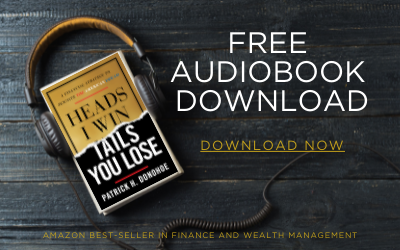Have you ever wondered how banks stay profitable? Would it surprise you to learn that life insurance plays a key role in increasing a bank’s assets and reducing costs? Or that you could adopt a similar strategy for your own business, fund employee benefits, or create personal financial gain?
In this article, we’ll explain bank owned life insurance—what it is, how it works, and its pros and cons. Plus, learn how other corporations use life insurance to grow and protect their assets and how to find the right kind of insurance policy to help you do the same.
What Is Bank Owned Life Insurance (BOLI)?
Bank owned life insurance, or BOLI, is a specific type of life insurance that financial institutions have used as part of a wealth building and cost-cutting strategy since the 1980s. Here are the key components:
- A bank purchases permanent life insurance on key employees—usually through an insurance trust; the bank owns the policy (it pays the premiums) and the employee is the insured.
- The bank is listed as the beneficiary on the insurance policy and receives a tax-free death benefit when the employee dies.
- Growth of cash value (via a rate of return and non-guaranteed dividends) is tax-free and belongs to the bank to use as it sees fit, during the employee’s lifetime.
- Typically, banks use wealth accumulated in the policy to fund employee benefits at a significant cost-savings to the bank.
Why Do Banks Purchase Life Insurance?
In the 1980s, when the 401(k) became widely adopted as a way to replace company-provided pensions, banks looked to permanent life insurance policies as an alternative way to offer benefits and incentives to senior executives and other high-level employees.
Bank owned life insurance became a more common practice in 2004 when the Office of the Comptroller of the Currency (OCC) released a formal statement on the purchase and risk management of life insurance. This bulletin outlined BOLI guidelines for banks and ultimately led to more financial institutions utilizing life insurance for a greater number of employees.
In fact, at the end of 2020, two-thirds of banks in the U.S. list life insurance as a Tier 1 Asset on their balance sheets, with a combined cash value of over $182 billion.
There are two primary reason why banks purchase permanent life insurance for essential employees:
- Increased tax advantages
- Less expensive employee benefits
When a bank pays premiums on an insurance policy, those premiums are considered tax-free. Similar to when you put money into a 401(k), the bank doesn’t owe taxes on income it uses to pay insurance premiums. Further, capital gains from the performance of the policy’s cash value are also tax-free, as is the death benefit. All of these tax advantages add up and significantly increase the amount of wealth a bank gets to keep, rather than paying to the IRS.
On top of tax advantages, the growth of cash value in a bank owned life insurance policy offsets the cost of employee benefits. Cash value can be used for a variety of benefits, including retirement and those employee benefits, as well as for employee compensation. It can also be used as insurance on borrowers or as loan security.
Sometimes banks will use a policy’s cash value to further incentivize an employee through additional employee compensation or to attract new hires in the form of additional retirement income or other bonuses. Employees may be given some degree of access to their insurance policy, be it the cash value and its associated growth or a payout to a beneficiary of their choosing. There are several ways this can be arranged, including Section 162 Plans, Nonqualified Deferred Compensation Plans (NQDCs), or Split-Dollar Arrangements. Regardless of how it’s structured, BOLI can be used to encourage key employees to stay with a company long term.
In the event a key employee passes away unexpectedly, such as one of the major fund managers, the proceeds from their insurance policy can be utilized by the bank to train a new employee or create a lucrative benefit package that attracts a qualified replacement through enhanced employee compensation. It protects a bank’s assets including an executive’s life, in that key employees are considered assets, and facilitates an easier transition from one employee to the next in the case of an executive’s death.
How Does Bank Owned Life Insurance Work?
When a bank purchases life insurance on an employee, it has the option to pay annual insurance premiums or to pay all premiums in one lump sum upfront. Often, banks opt for a single premium because it allows the policy to immediately start accumulating interest and earning dividends, and will generate greater cash value over the lifetime of the policy.
For example, a single premium of $1,000,000 on a life insurance policy yielding 4% would increase annual cash value over a 10-year period as follows:
| Beginning of Year | End of Year | |
| Cash Value | Cash Value | |
| Year 1 | $1,000,000 | $1,040,000 |
| Year 2 | $1,040,000 | $1,081,600 |
| Year 3 | $1,081,600 | $1,124,864 |
| Year 4 | $1,124,864 | $1,169,859 |
| Year 5 | $1,169,859 | $1,216,653 |
| Year 6 | $1,216,653 | $1,265,319 |
| Year 7 | $1,265,319 | $1,315,932 |
| Year 8 | $1,315,932 | $1,368,569 |
| Year 9 | $1,368,569 | $1,423,312 |
| Year 10 | $1,423,312 | $1,480,244 |
In just 10 years, the policy earns $480,244 in tax-free gains and will continue to earn tax-free wealth for the duration of the insured employee’s lifetime.
Bank Owned Life Insurance: Pros & Cons
Pros:
- Compared to after-tax yields from other common bank investments like mortgage-backed securities, municipal bonds, and 5- and 10-year Treasuries, BOLI provides a more favorable—and often guaranteed—rate of return, averaging 3-4% annually. When factoring for corporate tax rates (typically 40%), the actual realized return may be closer to 5-6% annually.
- BOLI allows a bank to diversify its investment portfolio, including the ability to divest from the market, decreasing exposure to market volatility.
- BOLI is generally considered a low-risk investment.
- Growth of cash value is tax-deferred and can be used tax-free.
- Death benefits are tax-free.
- Investment yields and potential dividends offset the cost of employee benefits.
- BOLI can be used to incentivize employees and attract new hires.
- BOLI can be used to train replacement employees and ensure smooth business transitions from one employee to the next.
- BOLI immediately increases a bank’s return on assets (ROA) and return on equity (ROE).
Cons:
- When interest rates and loan yields from other types of investments increase, they compete with funds allocated for BOLI.
- If a policy is surrendered before the death of the insured, the gains are taxable and a 10% penalty is charged by the IRS. For this reason, BOLI is considered a long-term, illiquid asset.
- Policies purchased through insurance companies with less than A-grade credit ratings can expose the bank to increased risk.
- For the greatest returns, BOLI should be purchased as a single-premium policy, which has a high upfront cost.
Types of BOLI Accounts
Bank owned life insurance can be structured one of three ways:
General Account
A general account is the most common type of bank owned life insurance. It functions similarly to regular life insurance in that once the bank pays an insurance premium, the insurance company utilizes the funds as it sees fit—typically by investing in real estate and/or bonds. It is up to the insurance company to invest strategically and provide the best return and potential dividends back to the bank. The higher-rated the insurance company, the less investment risk.
Separate Account
A separate account utilizes a fund manager to help manage investments. This can allow a bank greater involvement in how its BOLI premiums are being used, but can also expose policies to greater risk, depending on the crediting rate.
Hybrid Account
A hybrid account combines both separate and general accounts. This offers greater transparency than a general account but with less risk than a separate account.
BOLI vs. COLI: : Which Is Better for Business Owners?
Bank owned life insurance is a product exclusively offered to financial institutions, but a similar product exists for companies. Corporate owned life insurance, or COLI, offers many of the same tax advantages as BOLI and can be used to generate business capital, incentivize key employees, and create a business succession plan. Here are the key differences:
- COLI premiums are not tax-deductible.
- If a policy is surrendered before the death of the insured, the gains are taxable but no penalty is charged by the IRS. For this reason, COLI is considered more liquid than BOLI.
The Wealth Maximization Account™
If you’re looking for tax-advantaged wealth, whether for your company or yourself, a Wealth Maximization Account™ utilizes mutually-funded whole life insurance structured for rapid growth to help achieve these benefits:
- Guaranteed rate of return + potential dividends
- Increased liquidity
- Asset protection
- Decreased market exposure & risk
- Increased cash flow
- Generational wealth/business succession
A Wealth Maximization Account™ facilitates a Perpetual Wealth Strategy similar to that used by banks when they purchase whole life insurance. Policies can be structured for personal use or for key employees and can be structured to fit a wide range of budgets and financial goals, including for tax-free retirement income.
Leveraging Paradigm Life’s Strategies to Maximize Your Wealth with Life Insurance
At Paradigm Life, we believe in taking a holistic approach to wealth-building—one that prioritizes cash flow, protection, and long-term growth. Just like banks use Bank Owned Life Insurance (BOLI) to increase liquidity and reduce costs, you can leverage life insurance to achieve similar benefits. However, we take it a step further by offering customized wealth strategies designed to align with your specific financial goals.
How Paradigm Life’s Strategies Mirror BOLI’s Success
While BOLI helps financial institutions build wealth, we’ve created strategies that allow individuals and business owners to achieve similar financial success. Here’s how:
1. The Wealth Maximization Account™
Our Wealth Maximization Account™ uses whole life insurance to create a tax-efficient vehicle for long-term growth. By structuring the policy to accumulate cash value, you can access liquidity when needed, all while enjoying tax-deferred growth and the potential for dividends. Similar to how banks use BOLI to fund employee benefits, you can use your policy’s cash value for business expansion, emergency funds, or even retirement income.
2. The Family Bank™
This strategy is built on the same concept as BOLI, but it’s designed for families and businesses to create generational wealth. With The Family Bank™, you leverage whole life insurance policies to create a self-sustaining financial ecosystem that helps you fund key expenses while protecting your wealth. The policy’s cash value grows tax-deferred and provides access to funds via tax-free loans, just like how BOLI helps businesses use accumulated funds for employee benefits and capital needs.
3. The Volatility Buffer™
The Volatility Buffer™ is another strategy that builds on the same principles used in BOLI. While BOLI helps banks reduce risk and exposure to market volatility, our Volatility Buffer™ helps you safeguard your investments from market downturns by using whole life insurance as a buffer.
Instead of relying on traditional retirement accounts that are subject to market fluctuations, you can draw from your policy’s cash value during periods of market volatility, ensuring that your portfolio is protected while still growing.
4. Business-Owned Life Insurance for Entrepreneurs
Much like banks use BOLI to offset the cost of employee benefits, you can use business-owned life insurance as a strategic tool for employee retention, succession planning, and business growth.
Paradigm Life helps business owners structure key person insurance policies that are tailored to protect key employees and business assets while providing tax-deferred wealth growth. These policies can also be used to fund buy-sell agreements, ensuring a smooth transition in the event of an employee’s death.
FAQs
Q: What is Bank Owned Life Insurance (BOLI)?
A: Bank Owned Life Insurance (BOLI) is a life insurance policy banks purchase on key employees. The bank is the beneficiary and uses the policy for building wealth and reducing costs, with tax-free benefits when the insured employee passes away.
Q: Why do banks purchase life insurance for employees?
A: Banks opt for life insurance on employees to gain tax advantages and provide cost-effective benefits. The tax-free premiums and the growth of the policy help in balancing the costs of employee benefits.
Q: What are the pros and cons of BOLI?
A: The advantages of BOLI include favorable returns, tax-deferred growth, and diversification of risks. However, it also carries cons like potential tax liabilities on early surrender and significant initial costs in single-premium policies.
Unlock the Power of Life Insurance for Long-Term Wealth Building
Bank Owned Life Insurance (BOLI) has been a powerful tool for financial institutions, enabling them to grow wealth, reduce costs, and protect key assets. The great news is that these same principles can be applied to individuals and businesses to achieve tax-free growth, financial protection, and wealth-building.
At Paradigm Life, we take the proven strategies behind BOLI and tailor them for entrepreneurs, business owners, and families. With our Wealth Maximization Account™, The Family Bank™, and The Volatility Buffer™, you can leverage life insurance to create financial security, enhance cash flow, and build generational wealth.
We believe in personalized strategies that align with your unique goals, whether you’re looking to grow your business, plan for retirement, or protect your assets. Working with a Paradigm Life Wealth Strategist, you’ll gain access to a customized, tax-efficient wealth strategy that sets you up for long-term success.
Ready to take control of your financial future? Schedule a free consultation today and learn how life insurance can be a cornerstone of your wealth-building plan.
At Paradigm Life we can customize a policy to fit your financial situation. Our expert Wealth Strategists are available to answer your questions and show you customized illustrations, outlining an individual plan of action to help you achieve your goals.  , no strings attached.
, no strings attached.







